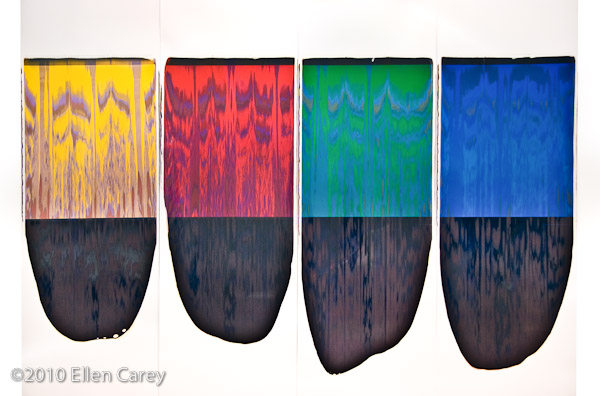One of the more unique artists working with Polaroid 20×24 technology today is Ellen Carey. Ellen first began using the 20×24 in 1982 while it was housed at the Museum of Fine Arts School in Boston. Ellen’s first work was a series of self portraits, lit with colored gels and later painted with enamel paint. These evolved into another series of self portraits made in New York that combined close up portraits lit with colored gels with intricate collages of black and white graphic images.
These multiple exposures blended the abstract and narrative in compelling complexity. In the 1990s Carey moved on to produce the series of “Pulls” and “Rollbacks”. Eliminating the figure altogether, Carey created these abstract images taking full advantage of the camera as a printmaking machine. Exploiting the roll film nature of the system, Carey produced pieces sometimes seven to ten feet in length by letting the camera run beyond its usual stopping point. At times, the positive would be cut away from the negative and “rolled back” into the camera for additional exposures and developing.
Here is an excerpt from the essay “Ellen Carey from Matrix to Monumental”, by Ben Lifson.
Nothing about either Polaroid’s 20 x 24 camera or its positive/negative material implies abstract pictures; one does not look at them and immediately see a combination of instrument and material ideally suited for the making of abstract art. The idea for the Pulls came to Carey in 1996, as though in a vision, hard upon her discovery of certain properties of the Polaroid materials while working “in a state of mourning” on an originally private symbolic project for the creation of whose symbols–if the panels were to originate in a lens’s depiction of appearances–the camera and materials were, as Carey discovered, the only eligible means.
“It was after I had buried my mother. …I went in [to Polaroid’s Manhattan 20 X 24 studio] to do an object…I had done a sketch of, called Family Portrait, just for myself, of the symbolic sequence of my family at that time, living and dead.”
There being no black-and-white material for the camera then, she used color film, photographing “black, which was no exposure, representing non-life, death, and white light,” for the living, reflected from a white rectangle. In doing this symbolic sequence…two coal black [panels] for my parents: my father died in ’79, my mother in April of ’96, after having lost her middle son,” (Carey’s younger brother John) “six months before. Then two whites for myself and my older brother, black for… John…then white for my two younger siblings….” she discovered that “the negatives were all the same matte black whether they were from black positives or white positives: rectangular voids with a tar-like patina that absorbed light. They resembled open burial pits.
“I had this kind of metaphysical experience…Almost slightly out of body. I know that living and dying [are parts of] the same process. We all know this. But here was the physical embodiment of it. I had a little charge, a little shiver down my spine. What Freud would call the ‘uncanny’.”
In this state of heightened awareness, and on “the same day, the exact same day,” she discovered the process that led to the Pulls.
“We were shooting and the…positive [white material] was at an end,” with “a little bit of black after it. I [asked] John Reuter,” the director of the Manhattan studio, ‘what is that?’”
“’Oh, it’s just the dyes exhausting themselves, the end of the dyes from the pod.’”
“‘What happens if we kept on going?’” “’I don’t know’”
She then pulled the paper out of the camera’s rollers past the default length of twenty-four inches, watching the behavior of the dyes “And that led to what I would call the first partial Pull, a white rectangle [with] a few inches of black with [a] sort of bib-like line. And I went from that to my first Pull,” in which the dyes, gradually retreating from the paper’s edges, form the parabolic shape central to so many subsequent pictures.
Continue to: Ellen Carey, 20×24 Polaroid Pulls and Rollbacks, Part 1
See full essay by Ben Lifson, “Ellen Carey, Matrix to Monumental”.















by John Reuter